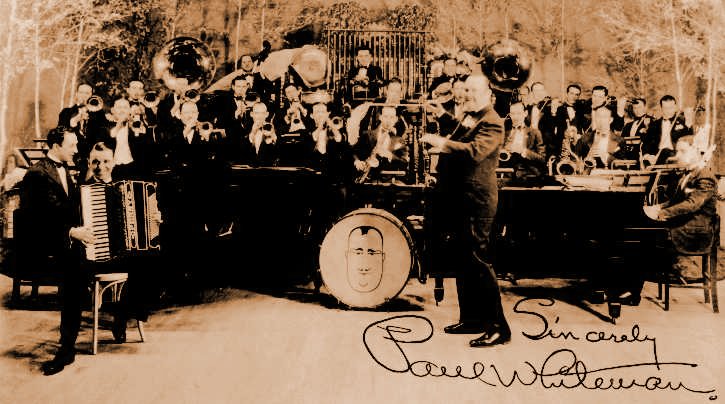The Deiro Brothers and the Rise of the Piano Accordion in American Culture 1908-1930
By Peter C. Muir
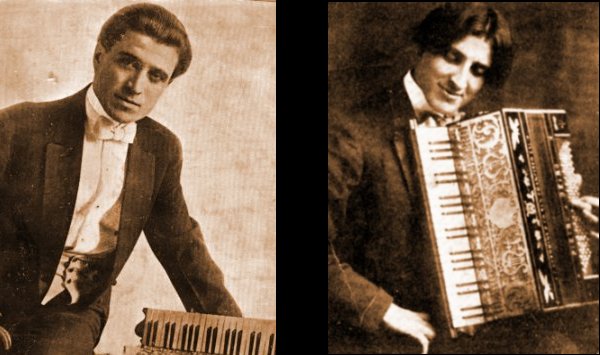
Guido and Pietro Deiro, photographs from the Guido and Pietro Deiro Archive at the Center for the Study of Free-Reed Instruments at the Graduate Center of the City University of New York, dated c. 1913 and 1915 respectively.
Yet within thirty years all that had changed, and the piano accordion was at the forefront of mainstream American culture. As a Washington newspaper noted in 1929, “the use of the piano-accordion is increasing by leaps and bounds.” It added:
Practically all the orchestras that are. . .on the radio are equipped with one of these instruments. Many of the hotel orchestras in New York City are similarly outfitted, and jazz bands and restaurant orchestras in the capitals of Europe are using one or more piano-key accordions. They are also employed by some steamship orchestras. [3]
Its popularity continued to grow rapidly with the onset of the Depression. In a feature on the instrument, The Etude remarked in 1931:
In a general survey, taken during the past winter, it was proven that, commercially, the piano accordion stands second to none other in popularity. While various standard instruments are either at a standstill in sales or on the downward trend, the piano accordion has been going ahead by leaps and bounds. [4]
Perhaps even more striking than the statement’s substance is its context: The Etude magazine, founded in 1883, was long the conservative voice of the American musical establishment. That the periodical chose to focus on an instrument of such humble origins, with a long association with popular entertainment, was a clear sign of its Eliza Doolittle-like acceptance into respectable musical society. [5] In short, by the beginning of the Depression, the piano accordion was about to come of age. In the words of one recent history of the accordion:
. . .it attained an unmistakable prominence in the mid-1930’s, and its popularity continued to accelerate through the 1950’s and even into the early 1960’s. . . This was the Golden Age of the Accordion. The accordion was KING, and it was just about everybody’s favorite musical instrument. [6]How had this transformation taken place? How had an instrument so little known at the beginning of the century risen to such heights in less than three decades? Just what was its appeal to the public? Questions such as these are not easy to answer, as they involve a subtle interplay of social forces, historical circumstances, musical factors, and issues of reception. In addition, the early history of the accordion in America is still a seriously under-researched area, and secondary sources only hint at an outline of a rich narrative. Thus I hope that this study of the Deiro brothers–Guido (1886-1950) and Pietro (1888-1954), [7] pioneer piano accordionists in America, and generally regarded as among the most influential in establishing the instrument in this country–will shed some light on these issues. In this I have been fortunate in having been granted full access to the personal memorabilia of both brothers, the first scholar to have been so favored. I am consequently indebted both to Count Guido Roberto Deiro of Las Vegas (Guido’s son) and to Sandra Cattani of New York City (Pietro’s granddaughter) for their generosity in allowing me unlimited access to these unique archives. [8]
Both Guido and Pietro Deiro were born in Salto, near Turin, Italy, the former on 1 September 1886, the latter two years later on 28 August 1888. [9] The family were prominent merchants and landowners–the entire region being known as Deiro–and there was a hereditary title, Conte, dating back to at least the fifteenth century, which was inherited by Guido, and which has since passed to his son. [10] In c.1902, Guido left Italy, apparently because of his unwillingness to work in the family business and to escape an arranged marriage, [11] and played his way up to Metz (then part of Germany, now in France) where he worked initially in the mines, and later, after the arrival of an accordion from Italy, in the Café Shanton, where he played until 1906. He then served for approximately eighteen months in the Italian army, playing various brass instruments, before emigrating to Seattle in 1908. [12] Pietro, meanwhile, had joined his brother in Metz in 1905, working first as a mason and later as a miner. In 1907 he arrived in the U.S., and settled in Cle Elum, Washington, about sixty-five miles southeast of Seattle, where he moved the following year, shortly before his brother’s arrival.
With both brothers newly arrived in America, there is considerable disagreement as to what happened next. The controversy stems from a 1935 article, “Who Was First? The Deiro Brothers Controversy,” [13] and a follow-up a month later entitled “Historical Controversy,” [14] in which it was suggested that both brothers claimed to have been the first to play the piano accordion on stage in America, Pietro in 1907 at the Washington Square Theater, San Francisco, Guido in 1910 at the American Theater, also in San Francisco. This is a complex issue, and only tangential to my narrative. Yet, given the passions it still arouses in the accordion world even today, I believe it worthwhile to review the evidence and see what conclusions can be drawn.
The claims that Pietro made in the “Who Was First?” article–that he was the first to introduce the piano accordion on the American stage in 1907 [15] --were subtly, but importantly, modified in the follow-up article of September 1935, where, in a sworn affidavit, he stated that he was the first to introduce upon the American stage an American-built piano accordion. This concession is highly significant, as it suggests that Pietro tacitly acknowledged that his brother was the first to play the piano accordion on the American stage (as Guido explicitly claimed in the same article [16]), though with the specification that the instrument in question was foreign-built. Furthermore the date was now emended to September 1909, not 1907. [17]
Pietro’s modified claim is entirely consistent with Guido’s lucid account in “The Life Story of Guido Deiro and Pietro Deiro.” In that version, Guido’s debut with the piano accordion seems to have taken place late in 1908 (or possibly early 1909: the narrative does not specify) at the Jackson Saloon in Seattle, where he was employed, apparently for a few months. According to Guido’s account, the instrument he was using was foreign-built. Although Pietro was also performing regularly at the time–at the Idaho saloon, also in Seattle–he was still playing a button accordion, not a piano accordion. Guido’s appearance at the Jackson Saloon was, therefore, the first known use of the piano accordion on the American stage. [18]
In Fall 1909, Pietro, at Guido’s encouragement, acquired his first piano accordion, which was specially made for him by Guerrini of San Francisco. [19] Pietro claims in his affidavit that this was the first piano accordion manufactured in America, and there seems no evidence to refute that claim. According to Guido, it was while visiting San Francisco to take his piano accordion back to Guerrini for redesign, that Pietro teamed up with a singer-guitarist named Porcini, with whom he formed an act called “The Milan Duo,” which was booked for a week at the Washington Square Theatre, a small venue in the city’s Italian district. [20] Guido does not give a precise date for this, but September 1909, as Pietro maintained on his affidavit, would seem to fit in approximately with Guido’s account. Of course, Pietro was by now using his piano accordion in the act, so both Pietro’s and Guido’s accounts agree that Pietro was the first to play an American-built piano accordion on the American stage. [21]
Guido made two other claims. He maintained that he, Guido, was the first to use the instrument specifically in vaudeville, rather than just on the American stage. This would have been in May 1910, when he was booked with Porcini on the Orpheum circuit for three weeks in Utah and California, again under the name “The Milano Duo.” [22] There is nothing in Pietro’s affidavit to contradict this. Furthermore, a letter by Gregory Romanoff supporting Guido’s assertion, published in The Accordion World, states that he (Romanoff) saw the Guido Deiro/Porcini “Milano Duo” in 1910 in the Orpheum Theatre in Spokane, Washington. [23] Guido’s other claim was that he was the first to play a solo piano accordion act, at the American Theatre, San Francisco, on 15 June, 1910. [24] This timing would fit in approximately with the earliest review that I have been able to turn up of Guido’s act, which dates from December that year. [25]
In all, it seems possible to reconcile the apparently conflicting claims of the brothers: Guido was the first to play the piano accordion on the American stage, to present a solo piano-accordion act on the American stage; and to play piano accordion in mainstream vaudeville; Pietro, as his affidavit claimed, was the first to play an American-built piano accordion on the American stage.
Whatever the circumstances surrounding the start of their American careers, both brothers were working full-time in vaudeville by 1912 or so. [26] Already by 1913, Guido had made his way to the top, playing at New York’s Palace Theatre, regarded as the Mecca of American vaudeville. [27] Both brothers were earning high wages. An extant work contract from 1912 shows Guido earning $450 per week, a substantial amount for the day. [28] Anthony Galla-Rini, another important vaudeville accordionist, claimed that Guido’s weekly fee went as high as $600, making him the best-paid solo instrumentalist in all vaudeville. [29]
The substantial salaries they commanded suggest that the Deiros were highly successful in their field. Their success, in fact, continued right up to the Depression. Vaudeville had already began to decline in the 1920’s with the rise of mass-entertainment genres, especially radio and, later in the decade, talking pictures. Despite this, the hundred or so surviving contracts of both Pietro and Guido from the 1920’s show the brothers maintaining a high level of fees throughout the decade. [30] This is particularly impressive when one considers that the novelty value of the piano accordion had long worn off for audiences by this time, and that the brothers were now being booked on their individual merits and as celebrities in their own right (see Fig. 1).
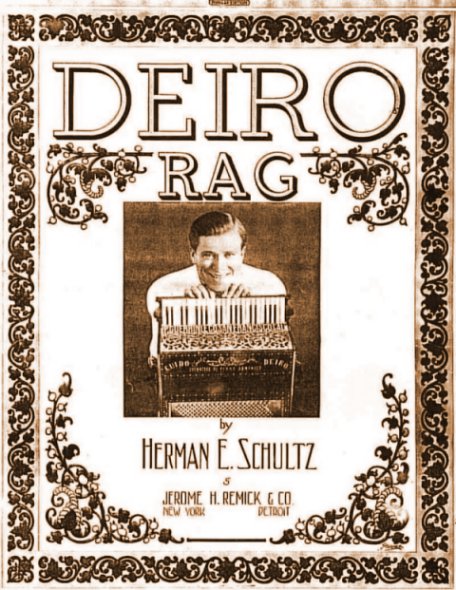
Fig. 1. Deiro Rag, issued in a piano arrangement by Herman E. Schultz in 1913, attests to Guido’s celebrity by this time. He was already a high-profile figure in vaudeville, and his Columbia records–including one of this composition–were selling well (Peter Muir Collection)
Vaudeville runs were usually a week or less, often just two or three days per town. Throughout their vaudeville careers, which lasted from the early teens to the late 1920’s, both brothers were, therefore, continually on the road. As an example, Pietro’s surviving contracts from 1922-1923 show him touring the following states and Canadian provinces: Virginia, the Carolinas, Florida, Georgia, Alabama, Louisiana, Tennessee, Minnesota, Manitoba, British Columbia, Washington, Oregon, California, Utah, Colorado, Nebraska, Missouri, Ohio, and New York, all during a period of nine months. [31]
This was clearly a most strenuous life-style, far more so than “legitimate” theatre, where a play or musical comedy often had a run of several months or more, and could thus give at least temporary stability to touring life. However, continuous exposure to large audiences in all parts of the country meant that, along with many of their major contemporaries in vaudeville, the Deiros soon acquired national attention, and eventually fame.
Even more important for their national exposure was the Deiros’ recording careers. In May 1911, Columbia records released what seems to be the first piano accordion record ever made: a ten-inch double-sided disc (Columbia A-984) of Guido playing Eilenberg’s Sharpshooters’ March and Pestalozza’s Ciribiribin. The record was commercially successful, outselling almost everything else in the May catalog, [32] and with Ciribiribin, for example, receiving at least eight different issues. [33] Like many other popular entertainers of the day, the Deiros move into recording grew naturally out of their vaudeville careers. By establishing a national audience through their touring, successful vaudevillians paved the way for the record companies, building up a widespread following which helped to guarantee sales. Indeed, Columbia’s publicity for Guido’s second record–Columbia A-1003, the waltz My Treasure and Variety Polka--made specific reference to his vaudeville background, promoting him as “this astonishing young accordion player [who] has recently become one of the sensations of the big vaudeville circuits in this country.” [34] That Guido’s first record was released less than a year after his debut as a solo act in vaudeville (which, it will be recalled, he stated was in June 1910) is a testament to the impact that he made on the public. Similarly, the hype for Pietro’s first Victor releases (numbers 17486 and 35345) made pointed mention of his “tremendous success in vaudeville.” [35]
The sheer quantity of the Deiros’s records is impressive. The comprehensive discography which I have compiled, and which will appear in issue four of the Free-Reed Journal (2002), lists every known release, and every issue of every release recorded by the brothers. Between 1911 and 1925, Guido released 103 sides with Columbia, four with the independent label Harmony, and two Edison cylinders. Pietro’s career was even more extensive, with 152 sides in all, issued over nearly a quarter of a century. After starting with Columbia in 1913 (presumably through his brother’s success with that company), he was an exclusive Victor artist by 1914 (Victor being Columbia’s major rival in America), a fruitful association that continued till 1935. As an epilogue to his career, he recorded ten sides for Decca in 1937. It is particularly impressive that Pietro continued to record for Victor even during the collapse of the record industry during the early 1930’s. That his records managed to generate sales during Victor’s darkest hour is a major testament to his popularity.
Guido’s records also sold well. The in-house trade magazine The Columbia Record advised in 1912: “…his records are good sellers, and Columbia dealers who are not making the most of them are not making quite as much profit as they otherwise would.” [36] Guido’s success as a recording artist is further confirmed by a surviving contract with Columbia. [37] Dated 31 October, 1919, it is for thirty-two selections to be recorded and released over two years at $600 per selection, a rate of nearly $10,000 per year, a most impressive sum of money for the time.
Many of the brothers’ records were released not only in the mainstream American market, but also in the domestic ethnic market. This is a complex subject, an extended discussion of which is beyond the scope of this paper. Suffice it to say that surviving copies of discs and catalogs show that Deiro records were released into numerous ethnic communities in the United States, including Italian-, Latin-, Dutch-, Polish-, Bohemian-, German-, Portuguese-, and Latvian-American. [38]
Thus, through their vaudeville appearances and records, the brothers were by 1920 household names, known to literally millions of Americans throughout the country, not only in the cultural mainstream, but also in many ethnic communities in large cities as well. The question is begged as to the reasons for this widespread success. In assessing this, I will draw extensively on newspaper reviews of their vaudeville appearances, as well as other contemporary sources. Before I do so, however, some background is required.
Although the brothers were the first to use the piano accordion in vaudeville, they most certainly were not the first with an accordion of any type. For example, Madame Suzette Carsell (1875-?), a button accordionist whose family emigrated from Italy c.1883, earned the name the “mother of the accordion.” She was discovered by Tony Pastor, a legendary promoter, and appeared in 1900, aged twenty-five, as “the first lady accordionist on the American stage.” There followed a successful twenty-year career in vaudeville, whereupon she married and settled in Phoenix, where she opened her own accordion school in 1924. [39]
Another example was the Brooklyn-born, diatonic button-accordionist John Kimmel (1866-1942). He too had a successful career in vaudeville around the turn of the century, and also, as the Deiros were to do, recorded extensively. His version of the then popular song Bedelia, made for the Zon-o-phone Company in c.1903, is the first accordion record made in America. His repertoire centered round traditional music such as reels, marches, and jigs, and his apparent inability or unwillingness to tackle newer genres such as ragtime caused his career to lose momentum in the 1910’s. [40]
Far more influential than either of these two figures was the button accordionist Pietro Frosini (1885-1951), who is generally regarded as one of the major personalities of the accordion in America. Born in 1885 in Sicily, he emigrated to the U.S. in 1905, and began a highly successful and long-lasting career in vaudeville. [41] He started recording in 1909–two years before Guido Deiro–and went on to have an extremely diversified recording career with many companies that lasted well into the 1930’s. [42]
Suzette Carsell, Kimmel, and Frosini, then, were some of the more prominent examples of a small, but successful, clique of solo button accordionists who were well established in vaudeville by the time Guido Deiro debuted with his piano accordion on the Orpheum circuit in June 1910 (indeed it was the success of such artists that must have pointed the Deiros in the direction of a vaudeville career).
It is not surprising, then, that, as the Deiros’ unfamiliar instrument was quite different from that of the earlier accordionists, it was singled out for attention by the reviewers, and was clearly part of their appeal, at least initially. In December 1910, for example, a description of Guido’s act in Variety noted the “The man plays what seems to be a little different arrangement than the usual. It has a keyboard similar to that of the piano.” [43] Other articles went into considerable detail to report on the instrument, such as this reverential account in the Pittsburgh Post:
The new instrument’s reception was not always sympathetic, however:
Likewise, during Guido’s tour of Australia in 1928, reviews again latched on to the instrument as much as the player, making it clear that, even by this late date when the piano accordion was fully accepted in America, it was all but unknown to the Australian public. For example, in an unidentified clipping in the GDA, the anonymous reviewer describes the instrument in such terms as to make it clear that this was his first encounter with it:
Clearly, however, the Deiros’ act was far more than just another novelty musical item of the sort that littered vaudeville at the time, [47] and this was widely acknowledged in the reviews which, from the outset, paid great heed to aspects of their performance other than the novelty value. An important feature was their charisma and a great ability to play to the audience. Reviews of Guido, for example, refer to the charm he cast in his performances:
More specific was a report in the San Antonio Light:
The most vivid account I have seen about Guido, however, comes not from a newspaper, but from a 1954 letter preserved in the papers of Jim Walsh at the Library of Congress. Walsh was a pioneer researcher who wrote the only discographical study to date of the Deiro brothers, published in Hobbies magazine in 1954, and it was this article which had inspired the letter of reminiscence. [50] The correspondent, one Lowell Henderson, recalls being taken by his mother to see Guido perform in Pennsylvania c.1919 (the Hendersons knew of Guido’s playing through his Edison cylinder of the Italian Army March, which was played “over and over” at the family home), and Henderson’s description makes it clear just how skillfully Guido worked an audience:
Pietro’s magnetism was, if anything, even more potent:
Another account refers to how Pietro “charmed his audiences until they sat spellbound. . .” [53] Elsewhere we read of “the happy smile, and that little stationary jig he does when he plays.” [54]
Carmen Carrozza, a protégé of Pietro’s in the 1940’s and 1950’s, and who saw him perform many times, commented:
Signor Deiro is playing what he is pleased to call a piano accordeon. It is a device of his own construction, combining not only the tonal qualities of the piano and the accordeon but five distinct instruments, namely, the first violin, the flute, the ’cello, the bass and the piano accompaniment in addition to its accordeon qualities. It looks like a huge, old-fashioned glorified accordeon. With the right hand the musician plays the melody on a miniature piano keyboard and with the left, the second part, a combination of instruments which sings the accompaniment. In the hands of the master it is a wonderful instrument capable of playing the most involved symphonies and at the same time the simplest harmonies. [44]
A fearful instrument that looks like a cash register, and sounds worse, produces gasps of pleasure at the Orpheum this week. It is called a piano accordion and its behavior is shameless. [45]
Deiro. . .presented a remarkable musical turn with his melo [sic] accordeon. The instrument, which looks like a miniature piano, was strapped across his chest, and Deiro extracted from it melody that had all the resonance of an organ at times. Chiming bells ringing out in a carillon of joy, or dying away in the distance, were simulated perfectly. . . [46]
Deiro plays with a telling grace and charms with the humor he evolves in his facial expressions, and he is easily one of the most popular musicians seen here this season. [48]
Temperamental, talented, he loses himself in his own melodies, becomes oblivious of his audience, one sees him apparently straining his hearing in an effort to hear the answering echo to his wonderful music, then with a laugh he comes back to earth. . . He’s a remarkable man, this Italian, and a real entertainer. [49]
Guido was quite short, but made up in stern commanding aspect what he lacked in height. Number after number he played on his great white accordion with never anything but a stern, almost ferocious countenance. The young country schoolteachers, especially the women, had never seen such rigidity of expression, and taking it as a challenge, tried as a group to make him smile. Toward the end of the concert they were winking and even waving hands, genteelly of course, in an effort to break down that face of stone. They succeeded, and as the final notes of the last number died away Guido made a big smile and the young and pretty school teachers squealed with delight. [51]
Pietro seems to cast a spell over his audiences with his uncanny mastery of his instrument breathless quiet reigning during his rendition of. . .the program. . . [52]
He was very tall. You’d know when he came into a room: [he had] a big presence. It was the same on stage. He would come in with that bright smile, a very attractive-looking smile, and he would capture an audience. Just to start off he would do that [55] (see Fig. 2).
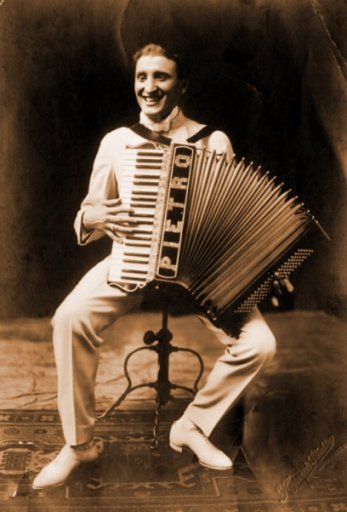
Fig. 2. “He would come in with that bright smile. . .and he would capture an audience.” Publicity photograph of Pietro Deiro taken c.1918 while on tour in Savannah, Georgia (Pietro Deiro Archive).
An essential part of the Deiros’ appeal with audiences was their choice of repertoire, for both brothers made a point of mixing light classics--flamboyant overtures in particular–with popular songs of the day. Many reviews cite this, often giving it as a reason for their success. For example, one critic suggested that “the manner in which [Pietro] quickly changed from the best strains of Italian opera to rag-time songs of the soldier boys, K’K’K’Katy and Oh, How I Hate to Get Up in the Morning made him a
hit. . .” [56]
In a similar vein, another reviewer discussed the same issue in greater detail relating to Guido’s performance:
This ability to meld the high with the low was a hallmark of their acts. It seems to have originated with Guido, who was, after all, the first of the brothers to work in vaudeville. It was also influential. In a 1940 interview, Pietro Frosini acknowledged how his own act changed when he realized what Guido was doing:
How come this mixture of genres was so successful? For one thing, such incongruity was entirely in accord with the philosophy (if that is not too pretentious a term) of vaudeville, where the emphasis was entertainment through diversity. As Wilmeth has expressed it, vaudeville “became a kind of American microcosm, integrating many separate parts into a whole.” [61] Second, and more importantly, although both brothers used classical items in their programs, these were all well known, popular numbers, taken mainly from familiar operas and operettas. Their act therefore had sophistication (reinforced by the Deiros’ immaculate appearance, about which many reviewers commented ) without posing a serious intellectual challenge, as a full-blown classical program would have done. It was, in other words, both entertaining and thoroughly respectable, a combination at the heart of mainstream vaudeville, which, by the 1910’s, had generally eschewed its seedy origins, and aimed to provide clean family entertainment for all.
One consequence of this is that the achievement of the Deiros went beyond just the mere popularization of the instrument: they also gave it both respectability and class. As one critic wrote of Guido in 1917:
Some reviewers expressed a similar view of Pietro. For example: “Pietro Deiro. . .through his masterful playing has raised the once little thought of piano-accordion to the dignified plane of the grand piano and cello. . . [63]
In fact, Pietro’s promotional material in the 1920’s quite deliberately reflected this image of respectability:
Thus the appeal of the Deiros was a combination of interconnected factors: the novelty of their instrument; their stage presence; the wide range of their repertoire; their general immaculate presentation; and, of course, their technical command of the instrument, which, though not usually spoken about directly, was part of the general “classiness” of their act, and a feature to which their surviving records bear witness. [65]
With the success of their vaudeville act and their recordings, it was to be expected that the Deiros would not be able to monopolize the piano accordion market for long, since the entertainment industry tends to capitalize quickly on lucrative innovations. It is, then, surprising that serious competition to the brothers did not emerge until the 1920’s, a testament to just how pioneering their work really was. In terms of recordings, for example, there are almost no other American piano accordion discs made before 1920: the only ones cited by Jim Walsh in his survey of early records of accordion music is a disc made in 1918 for Victor records by Phil Baker (who was to become a major attraction in vaudeville in the 1920’s) [66] accompanying the violinist Ben Bernie, and a certain “Le Vaux,” who recorded some records of popular music for the minor Aeolian-Vocalion label around 1919. [67]
This is not to say that the piano accordion did not make an impact on the general culture in the teens. Two events clearly show that it did. One was the creation of the San Francisco Accordion Club in 1916, the first such organization of its type in the United States. [68] Its thirty-nine members ranged from top professionals (including the two Deiros, the Boudini brothers, and Pietro Frosini) to those otherwise unknown, and it is clear from surviving photographs that piano accordions heavily outnumbered the button variety, [69] no mean achievement considering that the instrument had been unknown just a few years before. The club organized both concerts and the famous accordion picnics, which became the focal event of the accordion community in the 1920’s and thereafter. In short, the San Francisco Accordion Club marks the beginning of the institutionalization of the accordion in America (see Fig. 3).
With inevitable verve he plays selections that make a universal appeal, and puts his equally inimitable personality into each piece. Whether playing Hawaiian airs or classical music, he gives an individualistic but thoroughly correct interpretation. One of his most notable feats is to shift suddenly from a soulful, pathetic theme to a carefree, frivolous, saucy one, thus causing a swift but not unpleasant change in the emotions of his hearers. A wonderful effect was produced at Wednesday night’s performance when he broke off in one of the most pathetic passages of “Madam Butterfly” and launched precipitately into the catchy chorus of “Pretty Baby.” [57]
It was [Guido] bringing down the house with such tunes as “Alexander’s Ragtime Band” that prompted Frosini to change his programs from a strict classical repertoire with such classical numbers as “Poet and Peasant” [58] “Misserere”[sic], from “Il Trovatore” [59] to an opening overture followed by a medley of Irish jigs and songs, and continuing with such popular numbers as “Alexander’s Ragtime Band”, “Fiddle Up”, “Everybody’s Doing It”, etc. [60]
What a change Deiro has wrought! He has made the accordeon one of the most musical of all instruments, one who can play it well is accepted as an artist, and there is no better evidence of discriminating taste than appreciation of music such as Deiro’s. [62]
What Paderewski is to the piano, Spalding to the violin, and Hans Kronol to the cello, Pietro is to the piano accordeon. This man takes this instrument, which recently has attained a dignified standing among musicians, and gives it a human voice, a voice that is alive with joy, and dragged down to the depths of sorrow. [64]
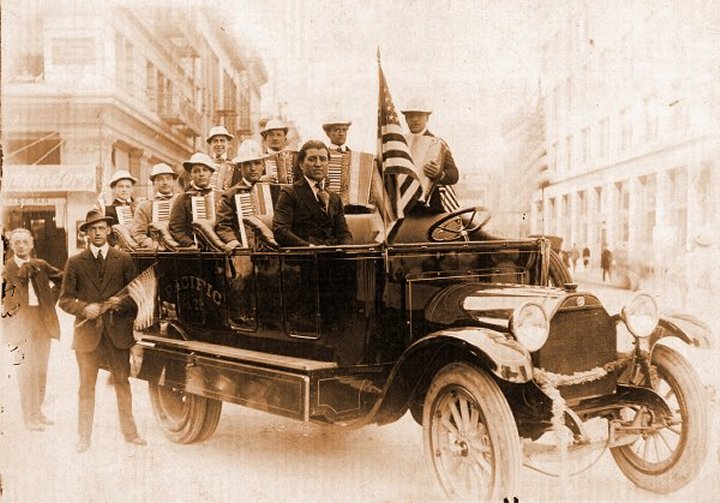
Fig. 3. Guido Deiro with unidentified fellow piano accordionists on a parade c.1919, an event most probably associated with the San Francisco Accordion Club (Guido Deiro Archive)
